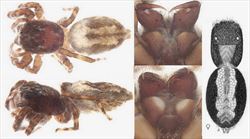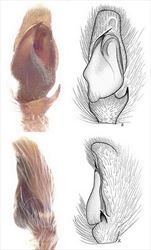
Examples of live Clynotis severus
Illustrator (and ©) R. Whyte (BR), I.R. Macaulay

Aspects of the general morphology of Clynotis severus
Illustrators (and ©) B.J. Richardson (CSIRO), M. Zabka (diag,) (QMB)

Palp morphology of Clynotis severus
Illustrators (and ©) B.J. Richardson (CSIRO), M. Zabka (diag,) (QMB)

Epigyne morphology of Clynotis severus
Illustrators (and ©) R. Whyte (TL), B.J. Richardson (CSIRO), M. Zabka (diag.) (QMB)
Clynotis Simon, 1901
Taxonomy
Clynotis has one described Australian species: Clynotis severus, formerly Clynotis viduus. Species previously in this genus have been moved to Pungalina and Tara by Richardson (2016). The genus is part of an Australasian clade (Maddison et al 2008) including Abracadabrella, Apricia, Holoplatys, Huntiglennia, Ocrisiona, Opisthoncus, Paraphilaeus, Paraplatoides, Pungalina, Tara, Trite and Zebraplatys (Maddison 2015). Further information on the genus and described species can be found in Richardson and Żabka (2017) and Whyte and Anderson (2017).
Description
Clynotis is a medium-sized spider, ranging in body length from 5 to 9 mm. The head is high in profile when viewed side-on and, when viewed from above, almost rectangular in shape. The abdomen is elongate-ovate. The chelicerae have a single retromarginal tooth (unident) and two teeth on the promargin. The legs are slender and relatively even in length. There is a commonly encountered melanic (black) form.
The male’s palp has a long, slender cymbium with a short embolus arising from a large base near the distal edge of the tegulum. The tegulum has a small proximal lobe. A short retro-lateral tibial apophysis has a suddenly-narrowed, sharp section at the tip.
The female has a single epigynal atrium, the copulatory openings near its posterior edge. Highly-convoluted, combined insemination ducts and spermathecae travel between and posteriorly to the atrium. Two large, laterally-located spermathecae, and a pair of parallel ducts are visible on each side of a median pocket in the epigastric fold.
Biology
Clynotis severus is found in habitats ranging from rainforest to desert. It is found in litter, on foliage and under bark.
Distribution
Clynotis severus is a common and widespread species found throughout Australia, including Tasmania. It is also found in southern Papua New Guinea.
References
Davies, V.T. & Żabka, M. 1989. Illustrated keys to the genera of jumping spiders (Araneae: Salticidae) in Australia. Memoirs of the Queensland Museum 27, 189-266.
Maddison, W.P. 2015. A phylogenetic classification of jumping spiders (Araneae: Salticidae). Journal of Arachnology 43, 231-292.
Maddison, W.P., Bodner, M.R. & Needham, K.M. 2008. Salticid spider phylogeny revisited, with the discovery of a large Australian clade (Araneae: Salticidae). Zootaxa 1893, 49-64.
Richardson, B.J. 2016. New genera, new species and redescriptions of Australian jumping spiders (Araneae, Salticidae). Zootaxa 4114, 501-560.
Richardson, B.J. & Żabka, M. 2017. Salticidae. Arachnida: Araneomorphae. Canberra, Australian Faunal Directory. Australian Biological Resources Study, at https://biodiversity.org.au/afd/taxa/SALTICIDAE.
Whyte, R. & Anderson, G. 2017. A Field Guide to Spiders of Australia. CSIRO Publishing: Clayton.
Żabka, M. 1987. Salticidae (Araneae) of Oriental, Australian and Pacific Regions, I. Genera Clynotis and Tara. Annales Zoologici, Warszawa 40: 437-450.
* The information sheet should be interpreted in the context of the associated diagrams and photographs. Diagrams explaining anatomical terms can be found in the ‘Salticidae’ pictures at the beginning of the list of genera.